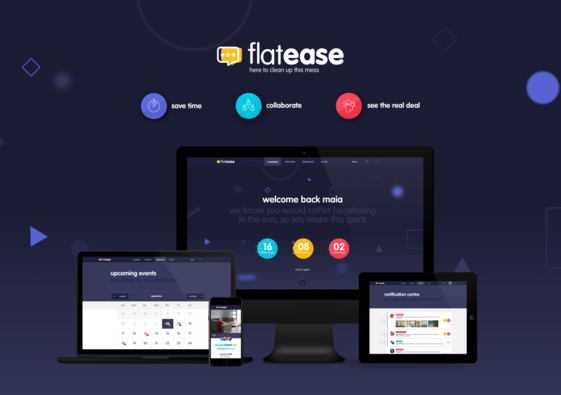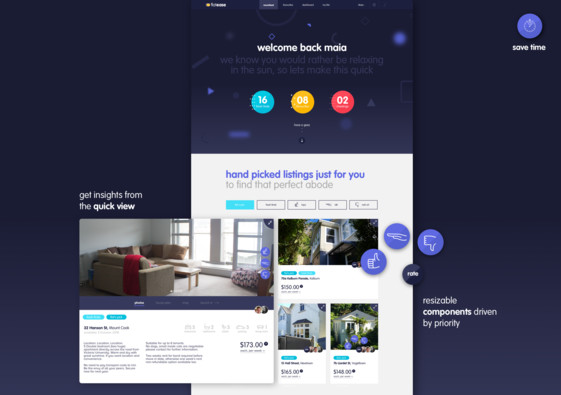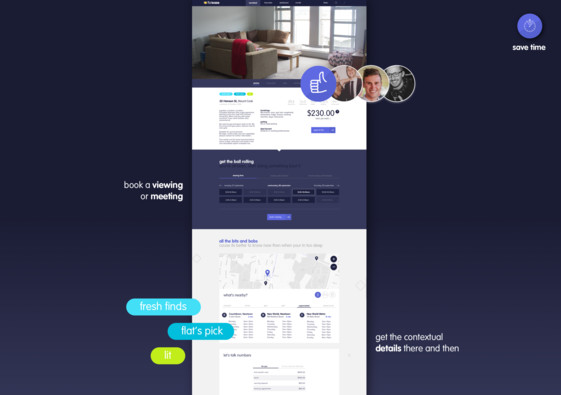In this interview we talk with Maia Visnovsky and Dayna Northwood, winners of a Student Gold for their project Wanderlink in 2016 and FlatEase in 2017.
Student Council Interview
Interview with Maia Visnovsky & Dayna Northwood
Introduction
Do you mind telling us a little about what you’re currently doing?
We've both working full time since leaving Uni at a magical place called Alphero, they are a strategy, design and delivery company. At work we do a lot of visual work creating concepts and reimagining wireframes, it also includes a lot of animations, working out micro-interactions and transitions which we are both super passionate about. We also do a lot of UX work, thinking through flows/functionality, making sure users get to their end goal. - Dayna & Maia
What was your first creative memory?
I was an avid Microsoft Publisher user. My parents couldn't get me off the computer. I would create anything I could whether it be cards, calendars or business cards. I couldn't count how many unnecessary bits of print collateral my family received. Looking back it makes sense that I ended up being creative on the computer for my career - I have been doing it ever since I can remember. - Dayna
This is a hard question! I guess my earlierst creative memory was redesigning the clothes that my dolls would wear. I would strip them down, grab toiler paper and paint differnet patterns on them and then literally glue them back onto the dolls! - Maia

Do you mind telling us about the project you won a Gold Pin for?
I have been lucky enough to win two, both for projects I completed while studying at Massey University so I can give you a brief description about both.
The first Wanderlink was designed to provide a way to monitor and track someone that is suffering from Alzheimers who has a tendency to wander by connecting an app with a wearable band. This was to prevent harm to the sufferer and reduce anxiety for their caregivers. A band that imitates a watch was chosen due to its familiarity, durable qualities and difficulty to remove making it hard for the sufferer to leave it behind. Connected with the app Wanderlink, the caregiver has the ability to set up safe zones and get notified through an alert when the sufferer leaves the safe zone. The interface changes into ‘danger mode’ in order for the user to understand quickly that the sufferer may be in danger. This design direction was chosen to aid the caregiver in a moment of high stress where they might not be able to think clearly.
The second FlatEase is an innovative responsive website that was developed to enhance the current flat hunting process which is geared towards searching as a group rather than an individual. It allows flatmates to collaborate together through many features like agreed preset filters, ratings, shared saved lists and commenting/booking on the listings itself. It also looks at speeding up the common processes such as applying by collating every members details digitally and combining that data. Lastly it provides smart spatial tools to get a better sense of space (such as 360 photos and VR). - Dayna
My first project that won a Gold Pin was a collaboration with Dayna Northwood – WanderLink is an app that assisted caregivers who were taking care of their loved ones that had Alzheimers. The app notified the caregiver when their loved once stepped outside their "safe zone" which the caregiver had previously set up. WanderLink then presented the caregiver with points of action such as calling for help or getting the directions to find them.
The second project which was my major project was also with Dayna Northwood (you can sense a pattern here). It was called FlatEase, this was the most exciting project I got to work on because all Dayna and I wanted to do was explore the technologies of VR. FlatEase helped your every day flat look and find new flats in a collaborative way. The current process is pretty messy, with usually the one flatmate looking and organising all the flat viewings. This platform allowed everyone to jump on board, have their say, keep track of upcoming flat viewings and more. It also allowed for the flatmats to jump into VR and look at a flat virutally together. - Maia

What was the most important thing you learnt at university?
Probably that if you try and you really want it, you can achieve it. That hard work truly does pay off. I saw a lot of people with huge natural potential but lacked the motivation, drive and passion to get there in the end. I am a huge believer that if you put the effort in you get the results. By pushing yourself, you can go beyond better rather than settling for good enough. This got seeded at university and has been reinforced at Alphero. - Dayna
Thinking. It sounds silly that after 4 years you come out with "thinking" but this is the most valuable skill. Technical things you get taught on the job, what software they use, how to use this tool etc. Thinking critically is a skill that takes time, practice, failure. - Maia
If you could go back to when you were starting uni, what advice would you give yourself?
To enjoy it. To get passionate. Design things you actually really care about. Get the most out of the briefs you get given. Most of them are open ended so that you can choose things that interest you. This is probably one of the only opportunities you get in life with the resources, time and support to actually design things that light the fire in your belly so use it! (unless you want to go unemployed and do it later in life) - Dayna
Don't worry! there are design jobs out there! You will make it. Believe in yourself and your skills you're a hard-worker and it'll pay off. Also, please don't go live in that mouldy flat in Newtown... pay a bit more to get something nicer and then you won't be off uni for weeks with a nasty chest infection. - Maia

How has an apparent failure set you up for later success?
I failed my 'Intro to VCD (Visual Communication Design)' paper. It really made me question what I was doing and whether design was actually the right choice for me. It was a real hit to my confience, although it taught me to believe in myself and my ideas. To trust my gut. It also helped me to learn what I said above around putting the effort in and getting the results. - Dayna
In my first real interview in the design world I got rejected, I was only at the start of my 3rd year - but this really hit hard. I started second guessing myself, thinking that maybe I wasn't a "good-enough" designer to make it in the real world. Started questioning if doing design was the right path for me... At the end of third year I signed up to Summer of Tech, where I received 4 differnet job offers to work with some amazing companies, and the funny thing was that the original company that said no, was now offering me a job. Bitter-sweet right?
What is bad advice you hear people giving design students?
I think mainly about jobs. Yes it can be challenging but if you actually try and are passionate about what you are doing you will find a job. The other would be to listen to everything that tutors say - I think you should but take everything with a grain of salt. You have done the research, you know what your trying to achieve, take their advice and ideas because they are normally great but at the same time don't loose sight of your goal. - Dayna
I sometimes hear people tell other students that they need to know everything there is about "Software X" if they want to make it. Currently we are using a lot of Sketch, and when I first started my job I didn't even know what that was. The biggest thing for us is attitude, it's the passion to learn and create great things. We never exepct students to come in and be a wizard in the software we use from day 1. So don't listen to those people who are telling you, you need to be a pro at a certain software, when you start a job the learning doesn't stop - it just continues. - Maia